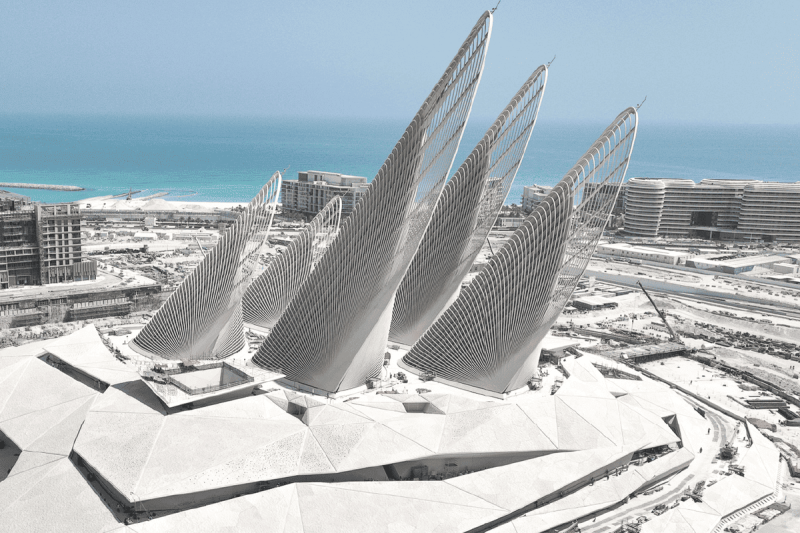Contents

Ruba Ahmed
You know those projects that make you stop mid-sip of your morning coffee and think, “Now that’s what architecture should be”? Abu Dhabi’s Zayed National Museum is exactly that kind of project. Set to open in December 2025 on Saadiyat Island, this Foster + Partners masterpiece isn’t just another cultural institution—it’s a profound architectural statement about heritage, sustainability, and the future of museum design.
Five soaring steel towers rising from the desert landscape like falcon wings, each one functioning as both cultural symbol and environmental solution. These aren’t just decorative elements—they’re solar thermal chimneys that draw hot air out of the building through natural convection. It’s the kind of integrated thinking that makes you appreciate why Foster + Partners has stayed at the top of their game for decades.
Architecture That Breathes With The Desert
The architectural approach here brilliantly combines contemporary efficiency with traditional Arabic design principles, creating something that feels both cutting-edge and deeply rooted in place. But let’s talk specifics—because that’s where this project really shines.
The museum’s pod-shaped galleries are suspended over a dramatic top-lit central lobby that’s cleverly dug into the earth to exploit its thermal properties. This central space brings together shops, cafes, and informal venues for poetry and dance performances, creating a perfect balance with the lightweight steel structures above. It’s environmental design at its most sophisticated—using the earth’s natural cooling properties while creating spaces that encourage the kind of spontaneous cultural interactions that make museums truly alive.
The falcon wing towers aren’t just metaphorical. Each of the five insulated stainless steel towers represents Sheikh Zayed’s deep connection to falconry, transforming a cultural symbol into functional architecture. This is parametric design with real purpose—where every curve and angle serves both aesthetic and environmental goals.
A Living Memorial to Vision
As both monument and memorial to Sheikh Zayed bin Sultan Al Nahyan, the UAE’s founding father, this museum serves as the centerpiece of Saadiyat Island’s Cultural District. But what strikes me most about this project is how it avoids the trap of creating a static shrine. Instead, the museum sits within landscaped gardens based on a timeline of Sheikh Zayed’s life, making the building part of a larger narrative about transformation and growth.
The star exhibits tell their own story of cultural continuity and innovation. Visitors will encounter the world’s oldest natural pearl alongside an 1,100-year-old Qur’an—artifacts that span millennia of human achievement in this region. It’s exactly the kind of curatorial vision that transforms architecture from mere container to active participant in storytelling.
Beyond Individual Impact: The Cultural District Strategy
You can’t discuss this museum without acknowledging the broader urban vision at play. The Zayed National Museum joins teamLab Phenomena Abu Dhabi, the Natural History Museum Abu Dhabi, and Guggenheim Abu Dhabi—all scheduled to open in Saadiyat Cultural District by 2025. This coordinated opening supports Abu Dhabi’s ambitious target of 9.3 million visitors annually by 2030.
This isn’t just museum planning—it’s destination architecture. The kind of coordinated cultural infrastructure that transforms entire districts and creates new urban gravity. As architects, we should be paying attention to how this cluster strategy plays out, because it represents a significant shift from the standalone icon approach that dominated cultural architecture for the past few decades.
Sustainable Innovation That Actually Works
Here’s where Foster + Partners shows their technical mastery. Those five towers function as solar thermal chimneys, using natural convection to move air through the building without relying heavily on mechanical systems. In Abu Dhabi’s climate, this isn’t just environmentally conscious—it’s operationally essential.
The building demonstrates how parametric design can solve real environmental challenges rather than just creating formal complexity for its own sake. Every element serves multiple functions: cultural symbolism, structural efficiency, and environmental performance. It’s the kind of integrated approach that makes you reconsider how we typically separate formal, technical, and cultural concerns in our own work.
What This Means For Museum Architecture
The museum positions itself as a “research powerhouse,” suggesting an institutional model that goes beyond traditional exhibition spaces. This reflects a broader shift in cultural architecture toward buildings that support active scholarship and cultural production, not just passive consumption.
The integration of performance spaces within the central lobby area shows sophisticated thinking about how contemporary museums need to function as community spaces. It’s not enough anymore to create beautiful galleries—these institutions need to support the full spectrum of cultural activity, from quiet contemplation to active participation.
The December 2025 opening will mark more than just another museum debut. It represents a new model for how cultural architecture can embody national identity while pushing forward environmental innovation. For those of us working in institutional architecture, it’s worth studying how Foster + Partners balanced these multiple demands without compromising on any front.
This project proves that sustainable design doesn’t require aesthetic sacrifice—in fact, it can drive formal innovation. The falcon wing towers work precisely because they solve real environmental problems while creating unforgettable architecture. That’s the kind of integration we should all be striving for in our own work.
Tags: Abu DhabiFoster + PartnersSteelZayed National Museum

Ruba Ahmed
Ruba Ahmed, a senior project editor at Arch2O and an Alexandria University graduate, has reviewed hundreds of architectural projects with precision and insight. Specializing in architecture and urban design, she excels in project curation, topic selection, and interdepartmental collaboration. Her dedication and expertise make her a pivotal asset to Arch2O.

